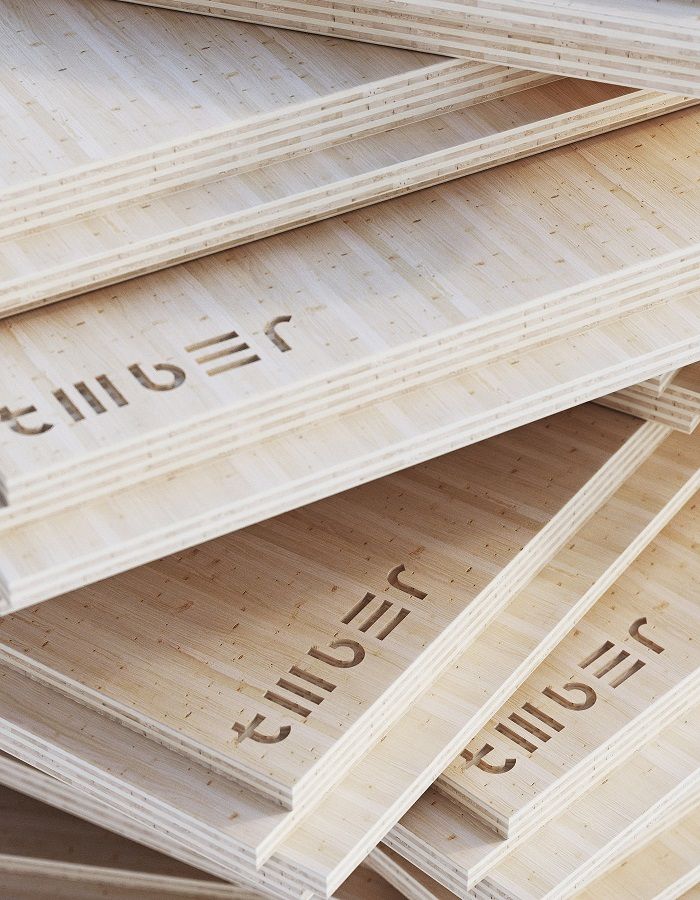
CLT - Cross Laminated Timber
CLT is a solid engineered, large scale prefabricated timber product, that has witnessed an impressive growth and has gained wider market acceptance at worldwide level, and it is currently perceived as medium for innovation, setting new benchmarks in the development of wood-based constructions everywhere.
It originates from Germany and Austria, where it was first developed in its modern form under joint research in the mid-1990s.Since then, it has become a popular choice and a favorite ‘green building’ solution for residential and non-residential constructions here and there.
Besides having a low environmental impact, CLTis largely appreciated for its strength and versatility: as lightweight as it is strong, it provides great acoustics as well as thermal performance, and has many advantages with design flexibility, transport and installments.
This massive construction product consists of at least three kiln-dried boards of lumber, that are stacked in crosswise directions, having been bonded by structural adhesives and pressed, in the form a solid, rectangular panel, with great stability and rigidity. This modern product is made available at various thicknesses and dimensions, proving once more to be suitable and advantageous alternative to other conventional construction materials.
Since previous dilemmas and questions about CLT construction have been well & truly answered, this versatile product is now firmly part of the 21st Century construction world.
Learn how we can support your upcoming projects!
How it’s made
Cross Laminated Timber is made out of dried lumber (spruce, and possibly larch, pine or hardwood), usually from 16 to 51mm in thickness, and 60 up to 240mm wide. The manufacturing process can be resumes as follows:
First, the lumber goes through smoothening operations, trimming and kiln-drying, thus reducing the amount of moisture to a percentage that will not allow either variations in terms of dimension, nor cracks. Finger jointing will remove a lot of limitations when it comes to feedstock dimensions.
Polyurethane adhesives are usually used to achieve this, but phenol-resorcinol-formaldehyde urea-formaldehyde (PRF) and melamine urea-formaldehyde (MUF) can also be suitable. When the layers’ direction is altered by 90 degrees, it helps the distribution of strength across both direction of the panel, allowing for the creation of a highly stronger end-product.
After they receive treatment, the timber boards will be stacked together in layers, which are commonly known as lamellas, with each of the lamellae positioned perpendicularly to the next one below.
For walls, maximum strength is provided by having placed the outer layers in the same direction in a parallel position to the vertical load. In most cases, a panel will be made out three layers, with 120mm in thickness, even though CLT can have a thickness from 50mm up to a maximum of 500mm.
Non-toxic, superior adhesives are used to glue together the lamellas, followed by hydraulic pressure, issued from cold bonding, to provide more strength. At the end of the manufacturing process, CNC systems are used to cut the final panels with high precision, including the openings for windows and doors.
As dimensions are concerned, the width of CLT panels is usually at 3.5m, with a typical length of 13.5m, but it can reach up to 22m. These panels consist of three to seven layers, and must be very stiff and stable, with the proper capacity to allow handling of heavy load and load transfers on all of their sides.



Key benefits of
Cross laminated timber
CLT panels can be subjects to various designs. The CNC systems can be used to cut panels at required specifications, to meet even the highest tolerances.
Moreover, these panel can be easily thickened in order to allow for longer spans.
CLT is a prefabricated product, which means that erection time can be significantly reduced, thus improving efficiency and helping to save some costs.
Moreover, the elements can be pre-cut for openings left to elements such as windows or doors. Other finishes or insulation can also be applied before installation, allowing for a reduction with work on site.
CLT panels with U-values operate as efficient insulators, as they are thicker. With their characteristic solidity, the CLT panels, they allow for little air flowing through the system.
As a consequence, the interior temperatures of interior CLT structures can easily be maintained with little supplementary cooling/heating. In addition, with their joints tightly fitted, the CLT panels provide a high energy efficiency
CLT is fabricated for specific uses and applications, meaning that the requirements for material are very precise, leading to little to no waste at all on site.
If any waste occurs, the scraps may easily be put ti use for other applications or as fuel.
Trials have revealed that CLT systems are great providers of noise control and air tightness, offering significant improvements to sound insulations.
Due to their increased cross-section thickness, CLT panels are slowly charring.
CLT structures used for type 4 constructions have less concealed spaces, leading to a reduction of fire ability to spread without detections.
Besides their high inherent thermal performance, CLT structures are beneficial to the environment in a number of ways: wood is a renewable product, and outperforms many other materials in terms of air pollution, water pollution or embodied energy.
Wood’s carbon footprint is quite light, because it constantly stores the carbon that the living tree is absorbing. Also, manufacturing wood takes up less energy, reducing gas emissions inside the environment.
Applications
Cross Laminated Timber (CLT) is widely used across Europe in the past years and hundreds of CLT structures have been erected across the world, including pioneering buildings such as Stadthaus, Murray Grove and Bridport House, which were until recently the tallest timber structures in the world.
Huge, new school buildings and academies have been built with CLT and there is now little doubt as to the benefits of this truly Modern Method of Construction (MMC) – the environmental benefits alone make it a popular choice for clients; speed of overall construction greatly appeals to contractors, whilst design freedom makes CLT the return to material for architects.
